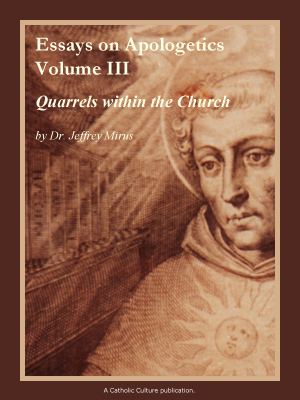The MOST Theological Collection: Catholic Apologetics Today: Answers to Modern Critics
"Chapter 7: A Faithful Text?"
Let us imagine St. Luke sitting down to write, or to dictate, his Gospel. Do we have the copy he wrote? Definitely not. There is no ancient work whatsoever for which we have the original copy or the autograph. How close are we? In the case of pagan works, a gap of nine to ten centuries between the autograph and our oldest manuscript is not unusual. For example, the oldest manuscript of Caesar's work on the Civil War, written in the middle of the first century B.C., comes from the tenth century A.D.
But in the case of the Gospels, we can do far better.24 The oldest complete copies we possess of the New Testament are the Vatican and the Sinai Codices, each dating from around 350 A.D. Far closer than the spread that exists for Caesar's work. We have also the Alexandrian Codex, and the Codex Bezae, from the early 400's A.D. But we can do something to narrow even this small gap. We have papyri25 giving parts of the New Testament. Thus, the papyrus called P46, the Chester Beatty Papyrus II, comes from the early 200's A.D. It includes most of the Epistles of St. Paul. Then there are the several Bodmer Papyri: P75 comes from around 200 A.D., and has parts of Luke and John; P66, from the same time, has parts of John; P72 has the Epistle of Jude, and the two Epistles of Peter. Oldest of all is the P52, the Rylands Papyrus 457, which has only four verses from John 18, but dates from 135 A.D.
We also have other checks on the state of the text, from the old translations. The Old Syriac and the Old Latin versions are earlier than the papyri in general, coming from the late 100's A.D. The Coptic and Sahidic translations date from the early 200's A.D. Thus, we can examine the state of the text that early.
Besides, the Fathers of the Church in the early centuries often quoted Scripture, and so we can see what their copies were like. Of course, they sometimes quoted from memory, not precisely word for word. But even then, the substance is surely correct.
Really, no scholar at all worries about whether our text of the Gospels is accurate or not. For with extremely few exceptions, the differences between one manuscript and the others are trifling. Even those differences that are larger have no bearing on the essential facts we will need to build the foundation for faith. So we do not, strictly speaking, have to take up this subject at all. Yet, for the sake of completeness and thoroughness, we want to continue in this vein.
There is a whole science that deals with the question of the faithful transmission of texts. It is called Textual Criticism. We will not go through every aspect of it here; we will examine only some major points.
Let us again picture a Scriptural author writing or dictating his Gospel. Printing was centuries away, of course, so copies had to be made by hand from that autograph. We do not know how many were made off that first copy. Let us imagine, for the sake of illustration, that three copies were made. Now when we copy even our own compositions, it is not unusual for us to make small mistakes in copying. So it is likely that the first scribes did that too. Further, it is not likely that the identical errors would be found in each of the three copies.
From each of the three copies, others were made by hand-let us imagine a half dozen from each. These further copies would be apt to reproduce the slips of the copies from which they were made, or to add slips of their own; and so on into further copies from copies.
The result is that there must have been, as it were, a family tree of manuscripts. The trunk represents the autograph; from the trunk come the three great branches; from the three come smaller branches; and so on.
From what we said at the start of this chapter, we can gather that there must be a "water line." In other words we could draw a line, perhaps horizontal, through this tree. We do have all manuscripts above the line; we have none of those below the line.
Then we try to figure out which manuscripts belong to which larger branches. For if two or three merely copy one previous manuscript, their testimony in this respect carries no more weight than the single branch from which they come. Therefore, to judge the correct reading, we cannot merely count manuscripts. We must try to reconstruct the family tree, and to see which manuscripts carry the greater weight, or seem more reliable. In doing this, of course, we look for small mistakes that are common to different manuscripts and for other types of common characteristics, so as to find the family traits.
Scholars today think the text found in the Vatican and Sinai manuscripts is, on the whole, the best.
After selecting the best family of manuscripts, we need to pick between the variations within them. There are many principles used for that. Let us mention just two that are especially important.
Suppose we have three variant readings at one spot and must pick. Clearly, if one of the three can more readily provide a ground or common base from which the others could have been derived, that one is more likely to be the original reading.
Secondly, we do well to pick that reading which best agrees with the known habits and tendencies of the author.
We could go into greater detail, but as we said, there is no need to work further here. All scholars agree that nearly all the variations we find in the Gospels are so tiny and insignificant that it is agreed that a good 90% of the text is above suspicion, and does accurately give the sense of the original. Those parts that do leave doubt are such that they are not needed for our work of building the foundation of faith. As we shall soon see, for that we need only a half
dozen very simple facts, physical facts, which are completely unaffected by the variants.






